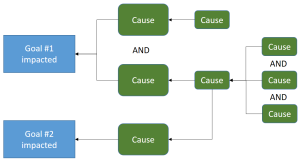Find root causes with the Enhanced Cause-Effect approach – MES029
 Find root causes with the Enhanced Cause-Effect approach
Find root causes with the Enhanced Cause-Effect approach
In the first two sessions about root-cause-analysis I have introduced the 5-Whys and the Ishikawa techniques. Both have their pros and cons.
For a long time I was looking for a better way to provide root cause analysis. More sophisticated than the 5-Whys, but not that compilicated and elaborate as the Ishikawa. And hereby I came across with an enhanced version of the regular Cause-Effect approach.
It’s again a graphical approach which combines simplicity and logic. It’s especially useful for situations in which multiple goals are affected.
The way to evaluate root-causes using the enhanced cause-effect is my preferred way. And that’s due to two reasons. First, it’s rather progressive and can be driven alone or in groups. You achieve quick results without spending too much effort into nasty categorizations or simplifications. Second, in it’s final stage provided as a diagram, it can be quickly and fully understood. You do not need verbose explanations how to read it or why some things have been dropped.
Stay tuned and be inspired.
Essential Answers Provided In This Episode For:
- What are the major drawbacks of 5-Whys and the Ishikawa?
- When to use the Cause-Effect approach?
- How to do the Enhanced Cause-Effect RCA?
- What are the goals of the affected situation or item?
- How to determine the causes which impact the goals?
- Why is it essential accumulate all causes and not only the preferred ones?
- Where to use the AND clause for combined causes?
- Why do even nitpicking details need to be mentioned?
- And much much more.
Selected Links and Resources From This Episode
- Boeing 777 Wing Break Test; Sorry, I haven’t found the video of the Airbus 380, but the 777 gives the same show.
- ThinkReliability
- The Titanic RCA by ThinkReliability
- Embedded World 2016 in Nuremberg

 I am a wholehearted SW-engineer on my journey to create a business supporting newcomers, seniors, managers and leaders.
I am a wholehearted SW-engineer on my journey to create a business supporting newcomers, seniors, managers and leaders.
Leave a Reply
Want to join the discussion?Feel free to contribute!